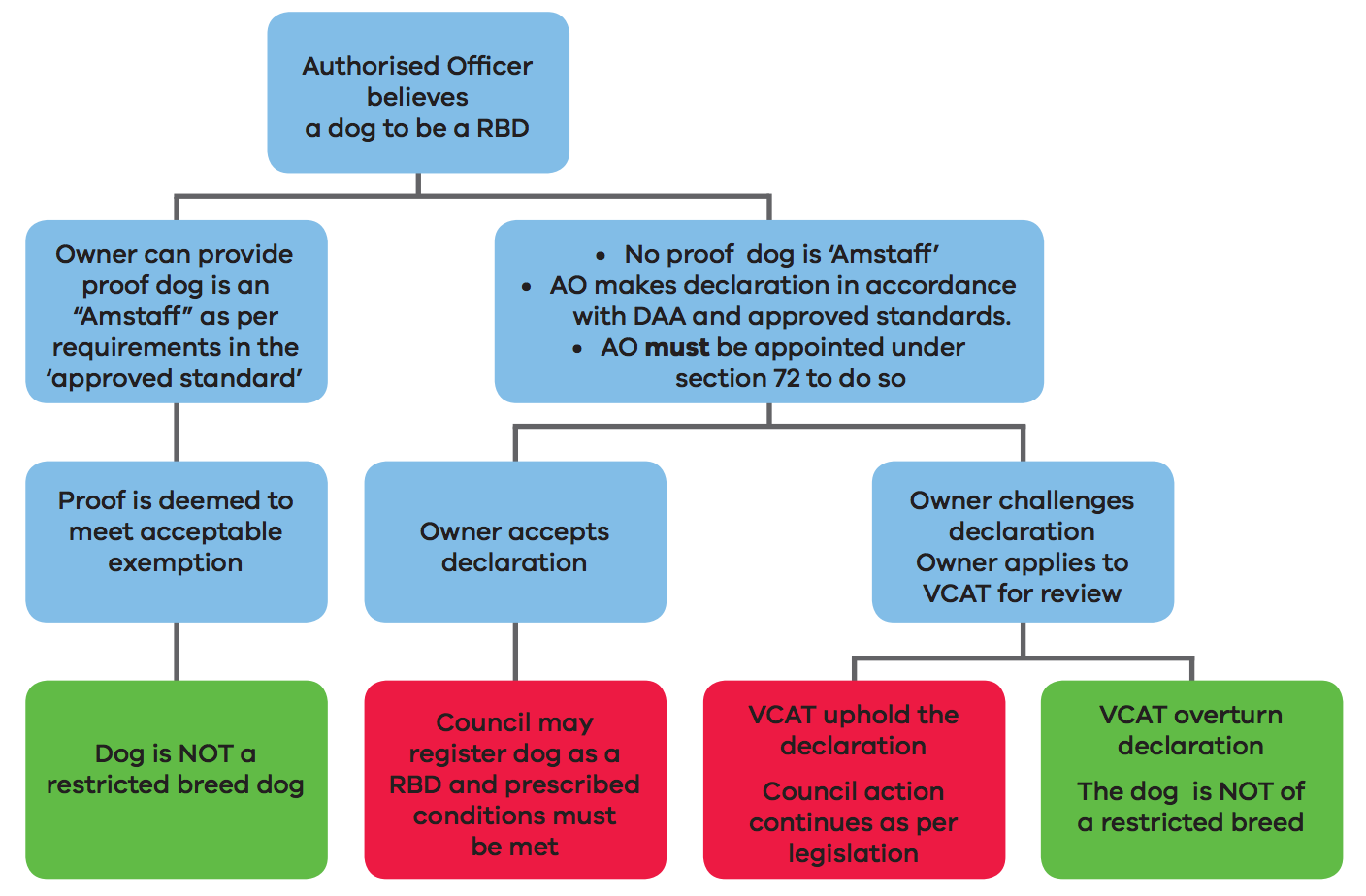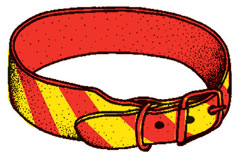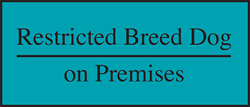Owning a restricted breed dog
Restricted breed dogs are defined as dogs that are, or fit the Victorian approved standard for an:
- American Pit Bull Terrier (or Pit Bull Terrier)
- Perro de Presa Canario (or Presa Canario)
- Dogo Argentino
- Japanese Tosa
- Fila Brasileiro.
To declare a dog a restricted breed dog, a trained council authorised officer, must make an assessment against the approved Standard for Restricted Breed Dogs in Victoria.
American Staffordshire Terriers
American Staffordshire Terriers are not restricted breed dogs in Victoria.
To provide evidence that a dog is an American Staffordshire Terrier, the owner must provide one of the following certificates:
- a certificate signed by a vet
- a pedigree certificate from a member body of the Australian National Kennel Council
- a pedigree certificate from a national breed council registered with the Australian National Kennel Council
- a pedigree certificate from the Australian National Kennel Council.
This page provides an overview of the requirements relating to a restricted breed dog, as prescribed in the Domestic Animals Act 1994 and the Domestic Animals Regulations 2025. There are penalties for non-compliance.
This information on this page can also be accessed from the Restricted dog breed fact sheet ![]() [PDF File - 170.7 KB].
[PDF File - 170.7 KB].
Keeping of restricted breed dogs
In 2014, the Government introduced additional laws governing the keeping of restricted breed dogs.
These laws are detailed in the following sections.
Offence for breeding a restricted breed dog
It is a criminal offence (with a maximum 6 months jail or 60 penalty units) for any person to breed a restricted breed dog — whether or not they are the owner.
The offence is committed if the person deliberately or recklessly allows the breeding.
It applies whether or not both dogs are restricted breeds, and when the breeding results in progeny (whether or not any progeny is a restricted breed dog) either born alive or stillborn.
If an authorised officer suspects that a restricted breed dog has been bred with they can request, under section 74C of the Domestic Animals Act 1994, a suitably qualified (s74B) authorised officer to take a non-invasive DNA sample from the dogs.
Samples can be sent to any of the following laboratories for analysis:
- (a) Genetic Technologies Ltd [ABN 17009212328]; and
- (b) Animal Solutions Pty Ltd [ABN 64116195352]; and
- (c) Orivet Genetic Pet Care Pty Ltd [ACN 166869503].
Owners are entitled to also take a DNA sample and send their samples to any laboratory of their choice.
Disqualification from dog ownership
A magistrate has the power to:
- disqualify a person from owning a dog
- put conditions on dog ownership, for up to 10 years.
This can apply in relation to the owner or person in control of a dangerous or restricted breed dog that attacks or bites.
Application to VCAT for review
After a dog is declared a Restricted Breed, owners can apply to VCAT for a review of the declaration. This must be done within 14 days.
Change in onus of proof for a declaration
Where an authorised officer has declared a dog to be a restricted breed dog, it is presumed in proceedings under the Act (and in VCAT) that the dog is a restricted breed dog (and the onus is now on the owner to prove otherwise) — in the absence of evidence to the contrary.
This applies only where the authorised officer who made the declaration has completed a course of training approved by the Minister for that purpose.
Power to take a sample
Authorised officers have the power to take a sample from a dog to help to determine whether the offence for breeding from a restricted breed dog has been committed.
Warrant to enter and search residential premises
Authorised officers have the power (with the approval of the Secretary) to apply to a magistrate for a warrant to enter residential premises and seize a dog.
This is for the purpose of determining whether the dog is the progeny of a restricted breed dog (even if the dog itself may not be a restricted breed dog).
A dog seized in accordance with the warrant must be returned to its owner within 3 days.
When a dog is declared a restricted breed
Authorised officers (from the local council) have the power to declare that a dog is a restricted breed.
Within 7 days of making a declaration an authorised officer must serve written notice of the declaration on the owner of the dog, either personally or by registered post. The notice will contain information about how owners can apply for a review of the decision, if desired, along with the housing and ownership requirements that apply to restricted breed dogs that can be kept.
Figure 1 provides a flow chart describing the declaration process including specific information about outcomes for dogs and owners.
Figure 1. Declaration process for Restricted Breed Dogs

If the Authorised Officer believes a dog to be a Restricted Breed Dog:
- The owner can provide proof dog is an 'Amstaff' as per requirements in the ‘approved standard’. If the proof is deemed to meet acceptable exemption then the dog is NOT a restricted breed dog.
- If there is no proof dog is 'Amstaff' the AO makes declaration in accordance with DAA and approved standards. The AO must be appointed under section 72 to do so. If the owner accepts the declaration, the Council may register the dog as a RBD and prescribed conditions must be met.
- If there is no proof dog is 'Amstaff' the AO makes declaration in accordance with DAA and approved standards. The AO must be appointed under section 72 to do so. If the owner challenges declaration, the Owner applies to VCAT for review. If VCAT uphold the declaration Council action continues as per legislation. If VCAT overturn declaration, the dog is not a restricted breed.
Conditions for keeping restricted breed dogs
Where the owner of a dog is under the age of 18 years, the parent or guardian of that owner will be deemed the legal owner of the dog and subject to any penalties.
Desexing
Restricted breed dogs must be desexed unless the owner obtains a certificate from a vet stating the dog cannot be desexed for health reasons.
Microchip identification
The owner of a restricted breed dog must make sure the animal is implanted with an ISO microchip in accordance with the regulations (unless already microchipped prior to 20 May 2003).
Within 7 days of the dog being microchipped, the owner must supply to the council where the dog is registered:
- the microchip identification number
- other information specified in the regulations
Collar

Whilst a microchip is a permanent form of identification — it is not visible. Restricted breed dogs must also wear a prescribed collar at all times. The collar is specially designed to be visible from a distance and reflective at night. This means that at all times, whether on the owner's property or not, a restricted breed dog can be recognised from a distance. This warns people of the potential danger of the dog.
Collars for restricted breed dogs must:
- be able to be securely fastened
- have at least one colour that reflects light in the dark
- be made of durable materials
- consist of red stripes alternately spaced with yellow stripes each being of a width of not less than 20 mm and not more than 30mm and set diagonal to the rim of the collar.
They must have a minimum width of:
- 25mm for a dog weighing no more than 40kgs
- 50mm for a dog weighing more than 40kg.
Warning signs
It is important for a person with a valid reason to enter the premises (for example emergency services personnel) to know a restricted breed dog is present.
The owner of a restricted breed dog must display prescribed warning signs at all entrances to the premises where the dog is kept warning people that a restricted breed dog is kept on the premises.
This warning sign must:
- be a rectangle with a height of 10cm and a width of 30cm
- be made of durable material
- have a 3 point black border around sign
- have a light turquoise background
- have at least one colour that is reflective
- have black bold 72 font, Times New Roman text.
An example is given.

For details of suppliers of restricted breed dog signs, contact your local council, or phone the Customer Service Centre on 136 186.
Housing on premises
When indoors or outdoors on the premises, the dog must be housed so that:
- it cannot escape
- visitors cannot be injured.
The dwelling and outdoor enclosure (or backyard where this forms the outdoor enclosure) must be constructed so that a person cannot access it without the assistance of an occupier of the premises who is of or over 18 years of age.
The owner must also have an outdoor enclosure or backyard that must:
- be constructed and maintained in a manner which prevents the dog from being able to dig or otherwise escape under, over or through the perimeter of the enclosure
- contain locks that have self closing and self latching mechanisms on any gates into the enclosure, which can be (and are) locked when the dog is in the enclosure
- have a minimum floor area of 10 square metres per restricted breed dog
- have a perimeter fence with a minimum height of 1.8 metres
- have a weatherproof sleeping area
- not be situated on premises in such a manner that people have to pass through the enclosure.
An authorised officer may also require that this perimeter have an inward facing overhang of 0.7 metres angled at 35 degrees to the horizontal plane.
In addition, you may be required to use the following construction materials for an outdoor enclosure:
- 50mm mesh, or weldmesh manufactured from 4mm wire with a maximum mesh spacing of 50mm
- brick, concrete, timber, iron or similar solid material
- chain mesh manufactured from a minimum of 3.15mm wire to form a uniform.
A combination of the above may be acceptable. The mesh size and construction detail is specified so that the enclosure will be escape proof and so that people, particularly small children, cannot fit body parts such as hands into the dog's enclosure.
Restraint off premises
A restricted breed dog must be muzzled and leashed when outside the owner's premises. The dog must be under the control of a person aged 18 or over.
Notification and ownership requirements
The owner of a restricted breed dog must notify the council that registered the dog, within 24 hours if:
- the dog is missing
- the ownership of the dog changes
- the owner's address changes
- the owner's address changes or the place where the dog is kept changes
- there is a change in the municipality where a dangerous, menacing or restricted breed dog is kept — owners must inform both the council of the municipal district in which the dog was previously kept and the council of the municipal district in which the dog is being kept within 24 hours of the change.
A person must not own more than 2 restricted breed dogs unless that person has a permit to do so from the council of the municipal district in which the dogs are kept.
Transfer of ownership of a restricted breed dog
Restricted breed dogs must not be:
- sold
- given away
- transferred to the ownership of another person.
The exception is:
- when the owner decides to surrender the dog to a council pound or shelter
- if the owner has died.
If the owner has died, the dog may be passed to an immediate family member of the deceased who is over 18 years of age.
Attacks by restricted breed dogs
If a certain type of dog:
- kills someone — owners can be jailed for up to 10 years
- endangers someone's life — owners can be jailed for up to 5 years.
These laws apply to owners of:
- attack trained dogs
- dangerous dogs declared due to attack
- declared menacing dogs
- guard dogs
- restricted breed dogs (both registered and unregistered).
For more advice or information
Call your local council if you have questions about your rights and responsibilities as a dog owner. Your council will also deal with queries or concerns about restricted breed dogs.